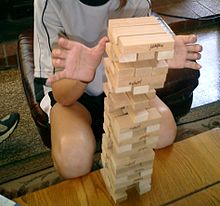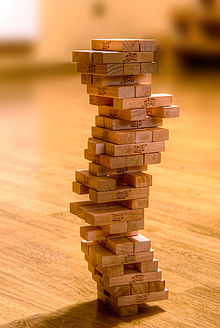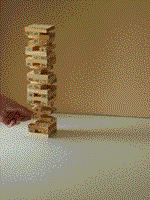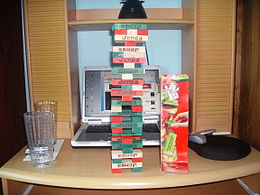
- Tabletop games
- Board games
- Tile-based games
- Turn-based games.html
- Abstract strategy games
- card games
- Connection games
- Mancala games
- Paper-and-pencil games
- Word games



 |
|
| Players | 2 or more |
|---|---|
| Age range | 6 and up |
| Playing time | Usually 5-15 minutes |
| Random chance | None |
| Skill(s) required | Manual dexterity, eye-hand coordination, precision, strategy |
Jenga is a game of physical and mental skill created by Leslie Scott, and currently marketed by Parker Brothers, a division of Hasbro. During the game, players take turns removing one block at a time from a tower constructed of 54 blocks. Each block removed is then balanced on top of the tower, creating a progressively taller but less stable structure.
The name jenga is derived from a Swahili word meaning "to build".
Jenga is played with 54 wooden blocks. Each block is three times as long as its width, and one fifth as thick as its length 1.5 cm x 2.5 cm x 7.5 cm (0.59 in x 0.98 in x 2.95 in). To set up the game, the included loading tray is used to stack the initial tower which has eighteen levels of three blocks placed adjacent to each other along their long side and perpendicular to the previous level (so, for example, if the blocks in the first level lie lengthwise north-south, the second level blocks will lie east-west).
Once the tower is built, the person who built the tower gets the first move. Moving in Jenga consists of taking one and only one block from any level (except the one below the incomplete top level) of the tower, and placing it on the topmost level to complete it. Only one hand should be used at a time when taking blocks from the tower. Blocks may be bumped to find a loose block that will not disturb the rest of the tower. Any block that is moved out of place must be returned to its original location before removing another block. The turn ends when the next person to move touches the tower or after ten seconds, whichever occurs first.
The game ends when the tower falls, or if any piece falls from the tower other than the piece being knocked out to move to the top. The winner is the last person to successfully remove and place a block.
Jenga was created by Leslie Scott, the co-founder of Oxford Games Ltd, based on a game that evolved within her family in the early 1970s using children's wood building blocks the family purchased from a sawmill in Takoradi, Ghana. A British national, Scott was born in East Africa, where she was raised speaking English and Swahili, before moving to live in Ghana, West Africa. Scott launched the game she named and trademarked as "Jenga" at the London Toy Fair in January 1983 and sold it through her own company, Leslie Scott Associates. The blocks of the first sets of Jenga were manufactured for Scott by the Camphill Village Trust in Botton, Yorkshire. The V&A Museum of Childhood has exhibited one of the original sets of Jenga since 1982.
In 1984, Robert Grebler, an entrepreneur from California who was the brother of a close friend of Scott, contacted her and expressed interest in importing and distributing Jenga in Canada. In April 1985, Grebler acquired from Scott the exclusive rights to Jenga for the U.S. and Canada, and then in October that year, Scott assigned the worldwide rights in Jenga to Grebler, which he in turn assigned to Pokonobe Associates. Convinced of Jenga's potential, Grebler had invited two cousins to form Pokonobe Associates with him in 1985 to increase distribution of Jenga. Pokonobe then licensed Irwin Toy to sell Jenga in Canada and to be master licensees worldwide. Irwin Toy licensed Jenga to Schaper in the U.S. and when that company was bought by Hasbro, Jenga was launched under the Milton Bradley banner. Eventually, Hasbro became licensee in most countries around the world.
Today, according to Leslie Scott, over 50 million Jenga games, equivalent to more than 2.7 billion Jenga blocks, have been sold worldwide.
 A jenga tower
A jenga tower Here, the Jenga tower collapses as a result of the incorrect block being pulled from the tower.
Here, the Jenga tower collapses as a result of the incorrect block being pulled from the tower.Packaging copy of one edition of the Jenga game claims that Robert Grebler may have built the tallest Jenga tower ever at 402⁄3 levels. Grebler built the tower in 1985 while playing with an original Jenga set produced by Leslie Scott in the early 1980s.
Throw 'n Go Jenga is a variant originally marketed by Hasbro and is currently being produced and marketed by Winning Moves. It consists of blocks that are colored red, blue, or yellow plus a six-sided die. Before each move, the player throws the die, and then follows the instructions on the die:
Other than the fact that the die determines the proper move, play continues the same as regular Jenga.
 Jenga Truth Or Dare Tower
Jenga Truth Or Dare TowerJenga Truth or Dare is an adult variation of Jenga also marketed by Hasbro. This version looks like regular Jenga except there are three colors of blocks, red, green and natural, instead of just the natural color of Jenga. Play is the same, but if a player moves a red block on that play, the player must complete the dare printed on it before stacking the block on top. A player who moves a green block must truthfully answer the question printed on the block before stacking it. The natural blocks have nothing printed on them and are played as in Jenga. However, it is permissible to write a player's own truths or dares on the natural blocks if desired.
Jenga Xtreme uses parallelogram-shaped blocks that can create some interesting leaning towers. Casino Jenga: Las Vegas Edition employs a roulette-style game play, featuring a felt game board, betting chips, and additional rules.
In addition, there have been a number of collector edition Jenga games, featuring the colors and logos of the Boston Red Sox, Oakland Raiders, New York Yankees, and John Deere, among others. Hello Kitty Jenga, Transformers Jenga, Tarzan Jenga, Tim Burton's The Nightmare Before Christmas Jenga, and Donkey Kong Jenga are some of the licensed variations of Jenga.
Jenga XXL and Jenga Giant are licensed giant Jenga games manufactured and distributed by Art's Ideas. Jenga Giant can reach 3 feet (90 cm) or higher in play. Jenga XXL starts at over 4 feet (1.2 m) high and can reach 8 feet (2.4 m) or higher in play. Rules are the same as in classic Jenga, except players can use two hands to move the eighteen-inch long blocks.
Jenga World Tour for Nintendo Wii and DS was released by Atari on December 7, 2007. A new version of the Jenga game for the Nintendo Wii is available from Electronic Arts as part of Hasbro's Family Game Night 2 offering.
An iOS version exists, released in late 2010 by NaturalMotion Games. NaturalMotion has also released versions for Android phones and Mac computers.
A very similar game called Ta-Ka-Radi was released in the USA by the Parsons family of Maine in 1978, five years before the commercial release of Jenga, but it was not invented before Jenga. Leslie Scott and her family had developed the predecessor of Jenga (which they called 'Takoradi Bricks') in 1974 when they were living in Ghana. The Parsons family did not invent the game. It had been shown to them by a friend recently returned from a visit to Africa. According to the Parsons, Dick Dickenson was that friend. The Dickensons and Scotts were acquainted. In fact, Leslie Scott was friends with Dick's youngest son, Bill.
According to Ta-Ka-Radi's website, this style of stacking block tower game originated in West Africa and "Ta-Ka-Radi is the original game as it has been played by generations of West African people," but there is no historical evidence for this claim that it was an ancient game. Many imitators of Jenga merely repeat the Ta-Ka-Radi website claim without any factual support.
There are two main differences between Ta-Ka-Radi and Jenga. In Ta-Ka-Radi, there are 50 tiles, and the tiles are placed on their narrow edge with gaps in between them. Jenga is played with 54 tiles, and the tiles are placed on their broad side without gaps between them.
Ta-Ka-Radi was sold through mail-order by L.L. Bean and Lands' End stores.